By Claire Bacon, ACN, CNC
Cell signaling is the process of cellular communication within the body. Our cells release and receive hormones and other molecules to communicate with other cells. As a process, cell signaling refers to a vast network of communication between and within each cell of our body. Cell signaling is dependent on having healthy cell membranes. We need a variety of fatty acids, oils, cholesterol, and other types of fats called phospholipids to build and maintain our cells.
What are phospholipids? These are certain kinds of fatty acids that line up and arrange themselves into two parallel layers known as a phospholipid bilayer. This is the layer that makes up your cell membranes and is critical to each of your cells’ ability to function.
Basically, nothing can work well in the body if your cell membranes aren’t healthy.
Symptoms of Poor Cell Membrane Health
We often see this when someone comes in with low energy, stubborn weight, and hair falling out. Maybe she’s already doing everything right: eating organic, intermittent fasting, and exercising with both cardio and weights. She may look insulin resistant, hypothyroid, and leptin resistant, but then you run testing and see that her blood levels are all normal. How confusing and frustrating! That’s when you know it must be something different. Maybe it’s the cell membranes?
You see, cell membranes have receptors for all different types of hormones, enzymes, and nutrients. You could think of it as a “lock and key” mechanism. In order for your thyroid hormones to work, the cell receptors have to pick up the hormone and “listen” to its message. All of our hormones are like directors to the cell. They enable the cell to absorb fluids and nutrients, and to flush out byproducts and toxins. It’s the membrane – not the nucleus – that’s in charge of these important decisions!
So, you can imagine how confusing it is to feel signs of deficiencies. You’ve done your research, you’ve checked off the list – you have all the signs of ____! Then you find out your thyroid is healthy, your estrogen is there, your insulin is at the right level… We’ve got to rethink your plan! Time to address the cell membranes better!
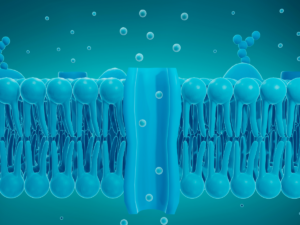
Today we take a deep dive into the inner workings of our cell membranes. Let’s discuss all the bits and pieces of what makes our cell membranes behave as they should…
Types of Phospholipids
Phosphatidyl choline
Phosphatidyl choline comes from soybean lecithin, precursor to the neurotransmitter acetylcholine. It plays a role in memory, movement, and metabolism; used to reduce fat deposits in the liver and under the skin. Found in eggs, red meat, nuts and whole grains.
Phosphatidyl serine
Phosphatidylserine also comes from soybean lecithin, key building block for brain cells, natural treatment for Alzheimer’s, age-related cognitive decline, depression, ADHD and improving athletic performance. Contains amino acids and the essential fatty acids EPA and DHA. Also helps: bone matrix formation, cell repair and removal by the immune system, heartbeat coordination, hormone secretion by the adrenal glands, and testicular function.
Aging naturally increases the brain’s need for phosphatidylserine, but it also creates digestive and metabolic inefficiency so it’s simply not possible to get enough phosphatidylserine in your diet. Stress simultaneously increases phosphatidylserine requirements and decreases your phosphatidylserine levels.
Phosphatidylethanolamine
Phosphatidyl ethanolamine (PE) is a major component of the cellular membrane. In humans, PE is the second most abundant phospholipid in the mitochondrial membrane (30–35%). Phosphatidylcholine is first (40–46%). PE is mainly synthesized by PISD (equivalent to bacterial PSD) located on the inner membrane (IM) of the mitochondria.
The importance of PE metabolism in mammalian health has recently emerged following its association with Alzheimer’s disease, Parkinson’s disease, nonalcoholic liver disease, and the virulence of certain pathogenic organisms.
Phosphatidyl inositol
Phosphatidylinositol and its various metabolites and relevant enzymes can be located and operate within different membrane regions in cells. It is both a membrane constituent and a required participant in metabolic processes in most life forms.
Phosphoinositides are signaling lipids derived from phosphatidylinositol, a ubiquitous phospholipid in the cytoplasmic leaflet of eukaryotic membranes. They have a key role in cell signaling, and impact all aspects of cell physiology and our resilience to disease.
Glycolipids
Glycolipids are lipids with a carbohydrate attached by a glycosidic (covalent) bond. The role of glycolipids is to maintain the stability of the cell membrane and to facilitate cellular recognition. This is crucial to the immune response and in the connections that allow cells to connect to one another to form tissues. Glycolipids are on the surface of all eukaryotic cell membranes, where they extend from the phospholipid bilayer into the extracellular environment.
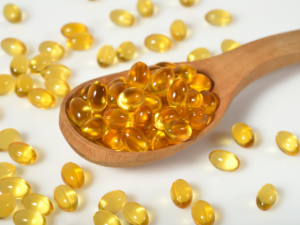
Omega 3s
Omega 3 Essential fatty acids – these are anti-inflammatory polyunsaturated fats, which play important roles in inflammation, heart health, and brain function. Omega-3 deficiency commonly coincides with lower intelligence, depression, heart disease, arthritis, and cancer. A bunch of things we don’t want!
Omega 3s are present in our dietary fish oil, fatty fish, and many other seafoods. Other forms exist in certain high-fat plant foods, such as flax seeds, flaxseed oil, walnuts, and chia seeds.
ALA
Alpha-linolenic acid (ALA) is the most common omega-3 fatty acid in your diet. It’s mostly found in plant oils and is an essential precursor of EPA or DHA. However, this conversion process is inefficient in humans. Only a small percentage of ALA can convert into EPA — and even less into DHA. When ALA doesn’t convert well to EPA or DHA, it is simply stored or used as energy like other fats.
Flaxseed oil is the best dietary source of Alpha-linolenic acid (ALA). Most guidelines recommend at least 1,600 mg of ALA omega-3 fatty acids daily for men and 1,100 mg for women. Just one tablespoon of flaxseed oil can meet your daily ALA needs. ALA is present in kale, spinach, purslane, soybeans, walnuts, chia seeds, and hemp seeds. It also occurs in some animal fats.
EPA
Eicosapentaenoic acid (EPA) in the body produces anti-inflammatory signaling molecules called eicosanoids. EPA may be superior to DHA for easing depression and reducing hot flashes. Both EPA and DHA are mostly found in seafood, including fatty fish and algae. EPA concentrations are highest in herring, salmon, eel, shrimp, and sturgeon. Grass-fed animal products, such as dairy and meats, also contain some EPA.
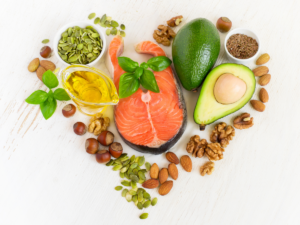
DHA
Docosahexaenoic acid (DHA) is an important structural component of your skin and the retinas in your eyes. DHA is vital for brain development and function in childhood, as well as brain function in adults. Early-life DHA deficiency is associated with problems later on, such as learning disabilities, ADHD, and aggressive hostility.
Consuming DHA may have positive effects on certain conditions, such as arthritis, high blood pressure, type 2 diabetes, Alzheimer’s, and some cancers. It can help reduce triglycerides and LDL (bad) cholesterol particles. DHA is found in high amounts in seafood, including fatty fish and algae. Grass-fed animal products also contain some DHA.
DPA
Docosapentaenoic acid (DPA) – is an Omega 3 fatty acid that reduces platelet aggregation, and improves lipid metabolism, endothelial cell migration, and resolution of chronic inflammation. Can improve neural health, may serve as a storage site for EPA and DHA.
Fish oil supplements and ingredients, oily fish, and grass-fed beef are the primary sources of DPA. Although the DPA levels in fish oils are substantially lower than those of EPA and DHA, concentrated DPA products are now becoming commercially available.
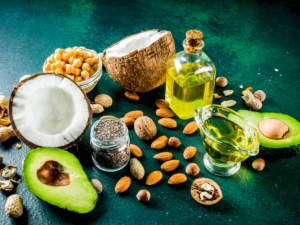
Omega 6s
Omega-6 fats are known as polyunsaturated fatty acids (PUFAs). Some research suggests that early humans consumed equal amounts of omega-6 and omega-3 fats and this was beneficial to their health. However, in modern times, Americans eat far more omega-6s than omega-3s.
Omega-6 and omega-3 fatty acids compete for absorption in the body. So, we can’t effectively use omega-3s when we have excess omega-6s. It’s crucial to maintain a balanced intake of both. The recommended ratio of omega-6 to 3 is between 4:1 and 1:1. However, our typical diet tends to have a much higher ratio of 20-to-1 or higher!
Oxidized, rancid, and overly processed Omega 6 vegetable oils are prevalent throughout our Standard American Diet (SAD). Canola, soybean, sunflower, and safflower oils are high in Omega 6s and have the potential to be healthy, but most commonly they are extracted with hexane and experience oxidation while exposed to light on the store shelf. We would do well to limit our consumption to these oils and to blends of other vegetable oils. We get more than enough just going out to eat in restaurants!
LA
Linoleic acid (LA), is not to be confused with Alpha-linolenic acid (ALA), the Omega-3 fatty acid mentioned above. It’s known as the parent fatty acid of the omega-6 series, and it is essential for human nutrition because it cannot be synthesized by the human body.
Linoleic acid is an important structural component of cell membranes and affects cell membrane properties like fluidity, flexibility and permeability. LA functions in many biochemical processes, like the regulation of blood pressure, blood lipid levels, immune function, blood clotting, inflammation and reproduction.
Foods that contain Alpha-linolenic acid often also contain some Linoleic acid. Sunflower and safflower oils are the top sources. Linoleic acid is further converted to gamma-linolenic acid (GLA) in the body.
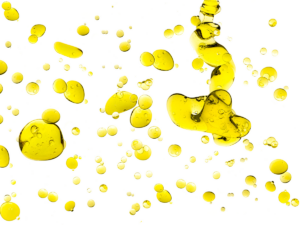
GLA
Gamma Linoleic Acid (GLA) – anti-inflammatory Omega 6 fatty acid found in Black Currant Seed Oil, Borage Oil, and Evening Primrose Oil. GLA can help lower your blood pressure, helps cells in your heart resist damage, and slows down platelet clumping in your blood vessels.
The body converts much of the GLA taken as a supplement to a substance called DGLA that fights inflammation. That’s why this one is really good for us! Having enough of certain nutrients in the body (including magnesium, zinc, and vitamins C, B3, and B6) helps promote the conversion of GLA to DGLA.
GLA is further broken down to Arachidonic Acid (AA) in the body.
AA
Arachidonic Acid (AA) – is a polyunsaturated fatty acid that, like other Omega 6s, is essential for normal health. It helps with fluidity and flexibility of cell membranes, especially cells in the nervous system, skeletal muscle, and the immune system.
AA modulates the function of ion channels, certain receptors and enzymes. It is integral for function of the brain and muscles. It is even protective against cancer tumors and metastasis.
AA and its downstream metabolites modulate our immune responses, which are critically important in resistance to parasites and allergens. AA acts directly on our eosinophils, basophils, and mast cells, and indirectly by binding to specific receptors on innate lymphoid cells.
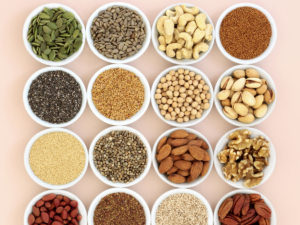
Did you know?
Endocannabinoids are natural derivatives of Arachidonic acid. These are important for brain reward signaling, motivational processes, positive emotions, stress responses, pain, and energy balance. That’s why CBD oil is so popular and good for everyone. It’s never contraindicated as long as it’s pure and unadulterated. We love hemp and CBD oil to help with anxiety, pain, and sleep.
Supplements to Promote Cell Membranes
Standard Process
Soybean Lecithin – this is one of our favorites when someone is dealing with high cholesterol. The soybean lecithin (a natural source of phosphatidyl choline and phosphatidyl serine) tends to clear excess LDLs and triglycerides from the blood. Especially useful in combination with Betafood and Cyruta.
Cod Liver Oil – one of our most popular fish oil products. Cod liver oil has stood the test of time, as it was commonly consumed by our grandparents. It is a rich source of EPA and DHA, and naturally includes vitamins A and D. Our favorite oil for wintertime!
Super EFF – this one is most useful for people who are not breaking down their fats well. If you can’t break down your fats into the essential fatty acid building blocks, then you’ll never get what’s needed into your skin, brain, or protective myelin sheaths. We often recommend this for neuro-degenerative conditions or when better nerve repair is needed.
Hemp Oil Complex – one of the newest products offered by SP, Hemp Oil Complex packs a big punch in a little bit of oil. polyunsaturated fatty acids (PUFAs, omega-3 oil) delivering essential fatty acids needed for the formation of specialized lipid mediators for a healthy immune response. Additionally, Brassica (TrueBroc®) is an important phytonutrient providing antioxidant support by activating the Nrf2/ARE pathways.
Biotics
EFA Sirt Supreme-BC – provides a balanced combination of EPA, DHA and GLA (from black currant seed oil), with all-natural mixed tocopherols (Vitamin E), specially formulated to be high in gamma (γ)-tocopherol.
Optimal EFAs– BC – supplies a unique balance of Omega-3, -6, and -9 fatty acids from fish, flaxseed, and black currant seed oils. Provides optimal ratios of ALA, EPA, DHA, GLA and oleic fatty acids. One of our most affordable blends!
Phosphatidylcholine – is a major constituent of cell membranes, and is important for normal cellular membrane function and repair. May help with brain function, ulcerative colitis, and many other degenerative conditions, including memory loss, cognitive decline, and liver disease.
Evening Primrose Oil – as a rich source of GLA, it’s fantastic for female hormones. Good for easing menstrual cramps, nourishing aging skin, and a useful remedy for hot flashes!
Researched Nutritionals
ATP360 – is literally a multivitamin for the cell membranes. Aside from B vitamins and other powerful nutrients for energy production, it has phosphatidylcholine, phosphatidylethanolamine, phytoglycolipids, and phosphatidylinositol. Available in office.


